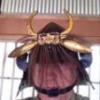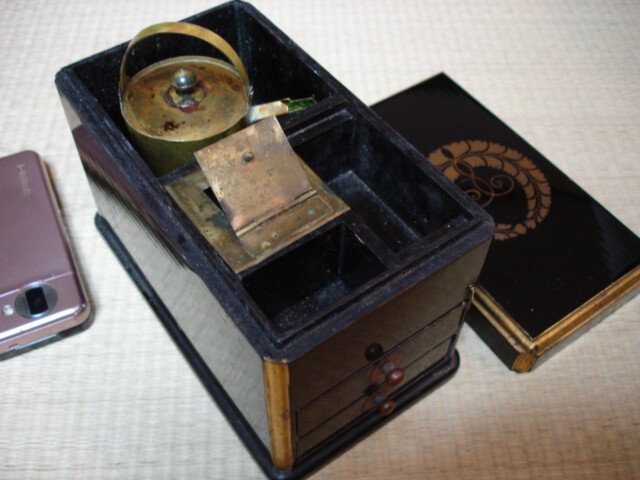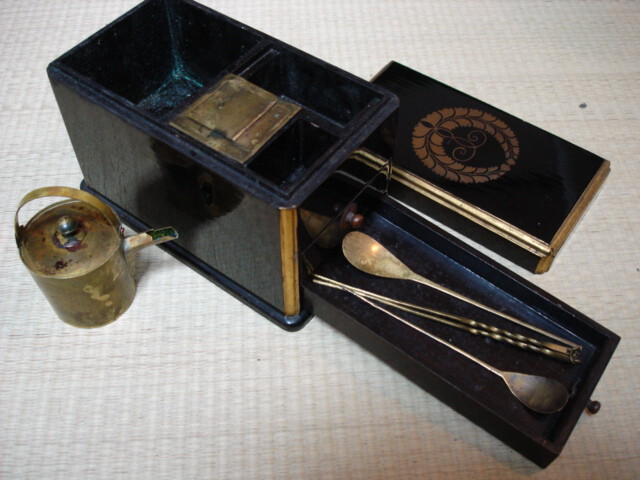-
Posts
14,054 -
Joined
-
Last visited
-
Days Won
258
Content Type
Profiles
Forums
Events
Store
Downloads
Gallery
Everything posted by Bugyotsuji
-
Bought a tanto in koshirae the other day for a song, mainly as a study piece. Cursory examination shows it to be a collection of both good and bad, but I would be grateful for anything you notice about it. The blade has a single Koshi-bi Hi on one side and narrower parallel Futasuji-bi on the other. Pics to follow when I get a minute. Preliminary questions. 1. The little tsuba, so small that you'd think the tanto was Aikuchi, seems to be made of wood, black and speckled with something? It is sandwiched between a collection of Seppa, not doing their job very well. Were/are wooden tsuba common? 2. There is little evidence of rust on the Nakago, despite the blade looking old to my untrained eye. Is it possible for an old blade to have a young-looking Nakago? 3. The machi has been moved up, (with a grinder?) in order to...? get the tanto blade legally under 15 cm and therefore not needing Toroku, perhaps? Is this common? Evidence of three holes having been made in the Nakago. I know that much Suri-age took place to fall in line with Edo etc. edicts, but here we may have a different example of a blade being altered in modern times in order to come back within the contemporary laws. In a rush!
-

Art in the Edo Period
Bugyotsuji replied to John A Stuart's topic in General Nihonto Related Discussion
Great site, John. Thanks for the link. -

can you help with transalation information please
Bugyotsuji replied to gumanthon's topic in Translation Assistance
There is a 'Translation' section here, John! -
Correct. http://www.amazon.co.jp/%E6%97%A5%E6%9C ... 369&sr=1-2
-
Beautifully done!
-
Why don't you reduce the sizes, or host the piccies on a web photo hosting site and provide a link for us? I am sure that everyone would like to see a joined-up overall view of your yari!
-
The tsuba is nice...
-
isnt the 6 kanji down another version of mitsu....3 horizontal lines Steve Apologies. Yes, there is a character for three there, but I thought you were referring to something in that tiny second photograph! Your date inscription seems to read (?) 明和二十年三月 Meiwa 20, the third month. Meiwa only lasted for 8 years though...
-
You've got better eyesight than I... :|
-

Toroku-sho? Naughty
Bugyotsuji replied to itsoverthere's topic in General Nihonto Related Discussion
Down the right it says, Type: Wakizashi Length: 35.8 cm Second line from right says, Sori: 0.8 cm Mekugi-ana: 1 Third, at top, middle, Mei inscription: Obverse & Reverse: (Blacked out) Left of that in large print: Fukuoka Prefecture Education Committee Further Left: Showa... 30 something (?) then Fukuoka Prefecture again (?) -

Toroku-sho? Naughty
Bugyotsuji replied to itsoverthere's topic in General Nihonto Related Discussion
PS What Brian said above. This area is potentially very tricky here in Japan. Once the police are alerted to any tiny irregularity you can be in serious sheet. Also it should be pointed out that the registration number is visible in that photo, so anyone seeing this could cause trouble if they wanted... -

Toroku-sho? Naughty
Bugyotsuji replied to itsoverthere's topic in General Nihonto Related Discussion
(The police will have authorized the legal continued existence of the sword itself at an earlier stage.) This registration certificate shown above is issued by the Education Authority, in this case for Fukuoka Prefecture. It notes the relevant sizes of the weapon, and the Mei or other inscription, and gives a date of registration which is not clear in your (Showa) photograph. Often people will make a copy, but yours looks like an original. It is a fairly old one of its type. Printed on the back are the relative paragraphs stating what the law says in regard to swords and guns of historical/artistic merit. By J law, all registered swords have to be deregistered before they leave the country. They would not probably know if you tried to send it back into Japan. -
Feeble attempt at joke. Apologies!
-
Thanks John. Nobody is better than me, but here is a rough translation: "Bamboo suit of armour. For peasant footsoldier. Sengoku Jidai. Originally owned by an old family household in Makioka Town. Bamboo armour uses a high quality hard bamboo Sane to protect the body instead of flat metal plates or Neri-kawa. With original Yoroi-bitsu." (Reserve the option to go back and edit as and when the inspiration strikes.)
-
All I can read under the photo is, "Bamboo armour.... for xxx soldiers, Sengoku Jidai". Can you get a clearer shot of the writing, John?
-

This Week's Edo Period Corner
Bugyotsuji replied to Bugyotsuji's topic in General Nihonto Related Discussion
Thanks Brian! -

This Week's Edo Period Corner
Bugyotsuji replied to Bugyotsuji's topic in General Nihonto Related Discussion
Nobody, no! But again you have found something unusual. Carlo, I think we can say that you've hit the nail on the head... (Still not able to post the final pic. Waited a full 5 mins while it told me it was uploading, but no further progress so I gave up.) Will try another ImageShack link instead. (Edit Brian..they are uploading for me. can someone else upload something and see if it works for others?) Oil pot, wick pot, oil lamp tools -

This Week's Edo Period Corner
Bugyotsuji replied to Bugyotsuji's topic in General Nihonto Related Discussion
The box is not big enough for all your stocks, Jean. You would need a dustbin or something for those... :D Oh, and the Mon is the 'wrong' way round because the lid fits on either way. I have changed the direction since those photos, Carlo, and thanks for pointing it out. -

This Week's Edo Period Corner
Bugyotsuji replied to Bugyotsuji's topic in General Nihonto Related Discussion
Re Hint No. 2 above and Ian's post. Was there a recent thread on that? If so, then no, not that thread! :lol: (Although not too far off...) Well, OK, Hint 3, it's not a game, but something that every house would need every day in some form or another. -

This Week's Edo Period Corner
Bugyotsuji replied to Bugyotsuji's topic in General Nihonto Related Discussion
The Romans crossed the River Flumen, John, on their way to Edo Jo Castle! Yes, I have an annoying habit of providing the English renderings next to Japanese words to make it easier for the lay reader... apologies for the dumbing down! John is now the closest, but I really do like the medicine box that Nobody found. I was sure it was Mah Jongg!!! OK, here's the next hint. (Maybe too big?) Hint Number 2 There is a recent thread on this site, and it pertains somewhat to that. In this sense the box is topical! -

This Week's Edo Period Corner
Bugyotsuji replied to Bugyotsuji's topic in General Nihonto Related Discussion
Nobody's there yet. But then I had no idea what it was at first. A Suzuri-bako was my first thought too. Let's see if the photos work today. Here is the first hint. The bottom drawer. Inside I found one of the Saji spoons that I had been wondering about and actually posted earlier on in this thread! This was maybe what tipped the balance in my decision to buy this box. You can also see a pair of small brass chopsticks linked together by a short chain. I added my earlier spoon to the drawer contents as it seems pretty similar. The second hint is... no, wait for it! PS Photos are not working today either, so using PhotoShack. (Edit Brian - pic uploaded fine for me?) PPS Ian got half of it right! PPPS The bottom drawer goes all the way to the back. The top drawer is half-sized. The mon could be right- or wrong-way round. I don't know. PPPPS The answer is not too exciting, so don't build up your hopes too high... -

This Week's Edo Period Corner
Bugyotsuji replied to Bugyotsuji's topic in General Nihonto Related Discussion
Well, if you enjoy a mystery, what do you think this box was for? Ian is not allowed to take part as he usually already knows everything before I have even discovered such things exist! (Except in the unlikely event that he doesn't know! Are you listening, Ian?) There is a Farmer's Market, as they call it, at the "South Village" twice a month. There are various stalls, most of which are flea-market (or as the J like to say 'free market') recycle type affairs, but with a few interesting antique stalls mixed in. An ex-Imperial Army soldier mans one stall there and gives me twisted grizzled looks, but he often has a few interesting bits. This was his offering last Sunday. Say if you want a hint... :lol: Tried for 30 mins, but photo won't post, so I am off to sleep. Maybe tomorrow. Erm... try this then: -

oil used before petrolium products
Bugyotsuji replied to Stephen's topic in General Nihonto Related Discussion
'Stone' 石油 Mineral oil was discovered way back in Nara times. (Nihon Shoki, it was called burning water, or burning soil.) But seeds were pressed for oil, including Camellia as mentioned above, and Sesame and Rape. 600-800 AD. Woods high in oil such as Matsu pine was popular for burning. As oil lamps became popular, and as people noticed which fats and oils burned well, many sources were used including animal (horse etc) and fish oils, apparently. As animals came to be considered impure, or killing them was banned under Buddhist laws, whale oil took over from horse oil. -
Could the character be 葛 I wonder, giving Kazura- or Katsu- or Kachi- ?
-
Visiting a local archaeology museum the other day I was surprised to see a brightly-shining mirror prominently displayed in a glass case. It was surrounded by very old mirrors and I thought of you, John. Close examination revealed that they had actually created a bronze mirror especially for the display and had polished it to show how it would have fuctioned new. It didn't seem to have anything coating the surface, just a bright orange-reddish reflection in which I could see my familiar handsome face fairly well. Incidentally, the small mirror (later adapted to be a Maedate) which I posted above was made by "Tsuda Satsuma no Kami Fujiwara Ieshige" and I found some material on the internet referring to a larger mirror made by this person in Kamakura in Einin 3 nen, (1295). This was certainly a line of mirror makers, rather like the swordsmiths, as you say. PS An antique dealer told me last month that the length of the the mirror handles gives an indication as to age, but I can't remember which way round he said. The longer, the... (?) PPS In your first post you ask what harm in polishing a mirror? I have noticed that J people are very particular to place mirrors facing down. Further, I have been told that the mirror is one of the oldest sacred objects in Japan, possibly even ranking with the sword in status and mystery. Even today I sense many Japanese people have a strongly susperstitious reluctance towards them.




